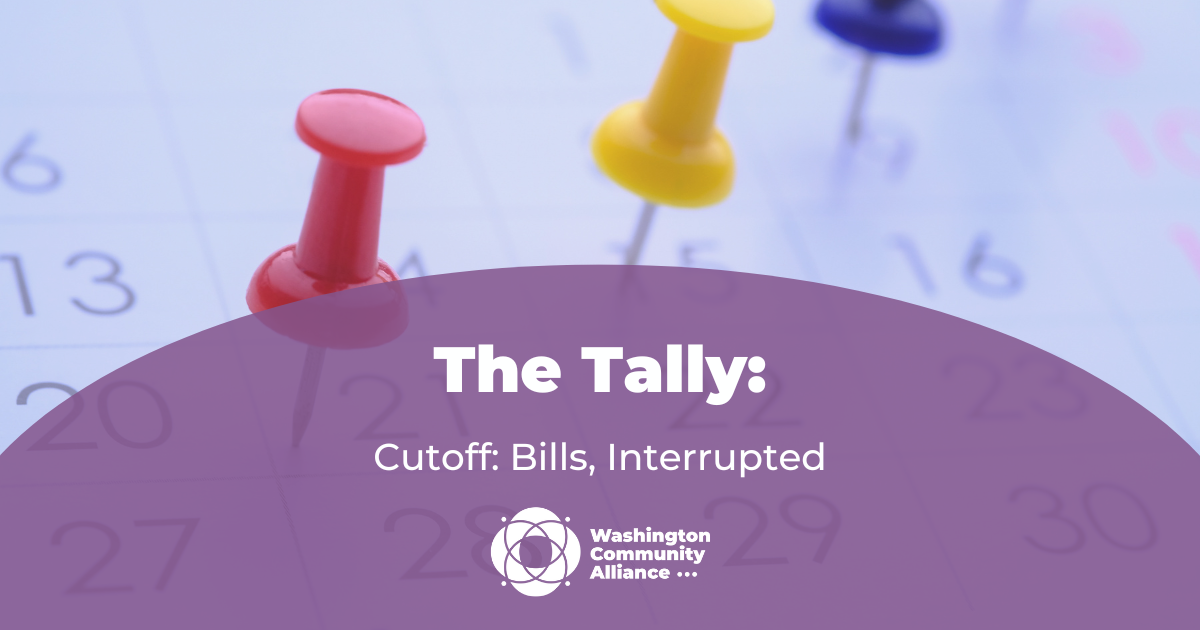
Habibtis—
Welcome to week five! We’re rapidly approaching cutoff. Offs are being cut. Cuts are being offed. And we’ve broken down what that means for you at the bottom of this newsletter (hint: bills gotta get moving!).
Read the news, take action!
✂️ Cutoff: Bills, Interrupted
Most bills have a House and Senate version but most bills also have a version that has more momentum, the main vehicle. That version has to move through the following committees by these cutoffs to stay alive. Check out our wayback blog post for how bills move through the legislative process. And if you want get into the wonky weeds, read the #waleg version here.
February 17th: Committee Cutoff – Bills have to be out of their committee of origin on either House or Senate side.
February 24th: Fiscal Committee Cutoff – Bills have to be out of the House Appropriations Committee or the Senate Ways and Means Committee.
March 8th: House of Origin Cutoff – Bills have to be voted off the House or Senate floor by this date.
If a bill isn’t voted off the floor of House or Senate by March 8th, it’s dead. If it passes the House or Senate by March 8th, it moves to the opposite chamber the goes through the same series of cutoffs:
March 29th: Committee Cutoff
April 4th: Fiscal Committee Cutoff
April 12th: Final Cutoff
If a bill isn’t voted off the opposite floor by April 12th, it’s dead. But we’re not quite done.
🤝 If the same version of a bill passes out of both chambers, the bill is good to go and heads to the Governor’s desk to be signed. Sometimes the House and Senate pass different versions of a bill. When that happens, the first chamber that passed it (House or Senate) has to decide if it will concur with changes to the bill made by the second chamber. If the first chamber says, “Sure. We’ll roll with it,” the bill passes! But sometimes the first chamber says, “Nah,” to the changes. When that happens, the second chamber can recede the amendments—basically accepting the first version of the bill that passed and giving up the changes they made to it. If they’re chill with that, the bill has passed. If the two chambers cannot resolve their differences on the bill, one of them can ask for a conference committee where members of both chambers meet to discuss the differences between the bills and try to come to an agreement. Sometimes conference works and sometimes it doesn’t. If House and Senate come to an agreement, the bill passes. If they don’t, it dies. What happens when a bill dies? We wrote about that here.
☠️ All of this bill movement and negotiation has to go down by the biggest cutoff date of them all: Sine Die. Sine Die translates as ‘without any future date.’ This year, that’s April 23rd.
🧟 There’s one final monster in the closet: Zombie Bills. NTIB (Necessary to Implement the Budget) bills aren’t subject to cutoff because they are necessary to implement the budget. This means they never die but walk the halls of power, undead zombie bills, until Sine Die whether or not they move out of committee or get a vote. It’s a bit murky what bills qualify. Some NTIB bills feel obvious: bills like the wealth tax that would make an enormous difference in the available revenue are NTIB. But others get labeled NTIB on mostly vibes. The President and Speaker have a good deal of sway over which bills get labeled NTIB. Sometimes the bills are, in fact, necessary. Other times, NTIB is a handy tool to keep legislation from dying.
What do you think? Have any questions? Tweet us your thoughts @WACommAlliance.
Keep up on the action and opportunities to get involved through our legislative newsletter, The Tally.

